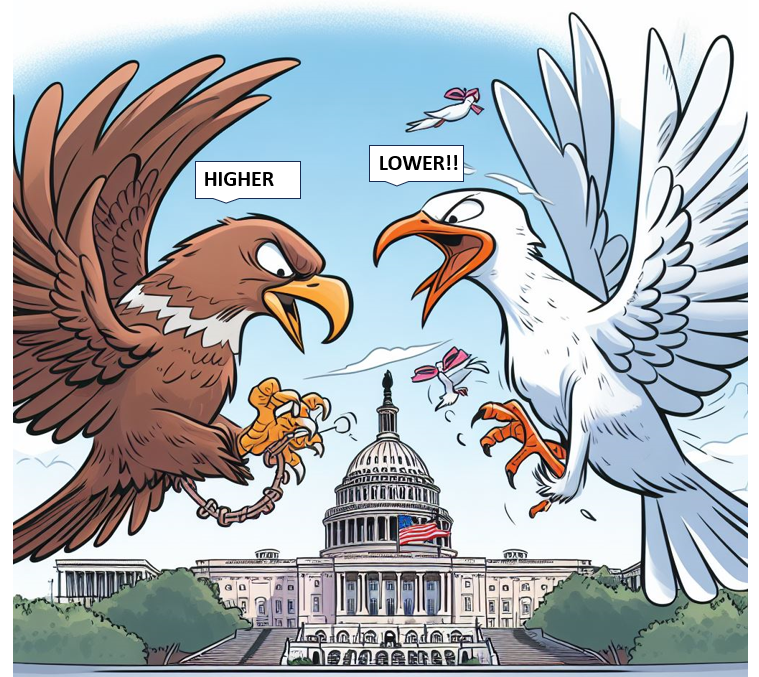
By Michael O’Neill
Hawks and doves are at it again.
The hawks reigned supreme in the aftermath of the September 20 Federal Open Market Committee (FOMC) meeting after the Summary of Projections predicted at least one more rate increase in 2023. The doves usurped them in the past week or so with a number of officials suggesting that there was not a pressing need for further interest rate increases.
Confused? You should be. The FOMC statement and Fed Chair Powell’s press conference were hawkish and the FOMC minutes confirmed that view when they were released on October 11.
For starters, one of the primary concerns expressed by the FOMC was the rate of inflation, which had persisted well above the committee’s 2% target.
Furthermore, the majority of participants felt that another increase in the federal funds rate might be necessary soon, with a consensus wanting to maintain a restrictive monetary policy stance until there’s concrete evidence of inflation returning to the 2% target.
The Committee also acknowledged that although labour pressures had eased, the job market was tight, which could lead to higher wages, fueling broader inflation increase.
The FOMC minutes justified the market reaction and bond traders hosted the party. They lifted the US 10-year Treasury yield from 4.30% on September 19 to 4.80% on October 3. The US dollar index soared from 104.30 on September 20 to 107.04 and the S&P 500 index plunged from 4443.95 on September 19 to 4229.45 during that time frame.
Then, Fed officials seemed to have a change of heart, which knocked yields lower, lifted stocks and sank the greenback.
Recent comments from Federal Reserve officials sounded dovish. While New York Federal Reserve Bank’s John William presented a hawkish perspective on September 29, an Michele Bowman had a similar stance on October 11, they appear to be outliers.
On October 2, Vice Chair Michael Barr suggested that policy might already be on track for the 2% inflation target, indicating less urgency for further tightening. This softer view was echoed on October 5 by Chicago Fed’s Austan Goolsbee, highlighting the inflation’s consistent trajectory lower.
Focus shifted to long-term rates in mid-October. Dallas Fed’s Lorie Logan and Vice Chair Philip Jefferson pointed to the mitigating effects of elevated long-term rates on potential policy adjustments. Adding depth, Cleveland Fed’s Neel Kashkari mused that these yields could self-regulate inflation.
On October 11, Governor Christopher Waller emphasized the evolving role of financial markets, hinting they might shoulder some of the inflation-controlling burden.
Oops! They did it again!

CPI rose 0.4% m/m in September, lower than in August but higher than forecast. The kicker is that the more important Core-CPI was unchanged at 4.1%, partly due to higher food and shelter costs. However, policymakers are likely to massage the inflation data message to avoid admitting that their dovish tilt was a tad premature. Many economists agree and believe the inflation reading isn’t enough to prompt another rate hike. It’s the same message they wrote following the blow-out US nonfarm payrolls report on October 6. The Kinks were right: “It’s a mixed-up, muddled-up, shook-up world, except for Lola.”
Financial markets think so and the doves took flight. Bond traders boosted treasury yields to 4.66% from 4.54%, and the US dollar index spiked to 106.17 from 105.40, snapping the downtrend from October 3.
The US inflation data doesn’t bode well for the Canadian dollar either. USDCAD jumped to 1.3701 from a pre-data low of 1.3595 and negated an intraday bearish technical signal in the process, suggesting more 1.3570-1.3770 range trading.
It is not all doom and gloom for the loonie. Some pundits speculate that the Canadian dollar will soon wear the mantle of a petrocurrency. CBC news reported that Canada’s oil production is expected to jump about 10% next year and become one of the largest sources of supply around the world. That’s because the Canadian government’s $35 billion expanded Trans Mountain pipeline will boost the pipeline capacity to 890,000 bpd from 300,000 bpd.
The Canadian government will enjoy higher royalties and pipeline transmission profits, but they won’t be enough to counter Canadian dollar selling pressure from external stresses such as geopolitical issues and US monetary policy. Historically, the Canadian dollar rallied on rising oil prices due to increased foreign investment in energy projects. That won’t happen now because of the Federal government’s rabidly anti-oil policies.
The feathers will be flying as rate hawks and doves battle for supremacy, and the Loonie is merely a spectator.

Source: Bing AI





